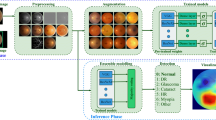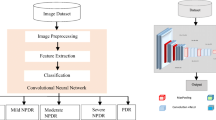Abstract
Diabetic retinopathy (DR) is an important retinal disease, which occurs commonly among diabetic patients. This disease severely injures the basic vision of the eye and results in blindness in several cases, which could be eliminated by earlier detection and medication. The existence of many classes in DR makes the diagnosis process difficult. To resolve this process, this paper introduces a new segmentation based classification model to classify the DR images effectively. The proposed model involves three main processes, namely, preprocessing, segmentation, feature selection and classification. The proposed method undergoes preprocessing and contrast-limited adaptive histogram equalization (CLAHE) model is applied for segmentation. AlexNet architecture is applied as a feature extractor to extract the useful set of feature vectors. Finally, softmax layer is utilized to classify the images into different stages of DR. The validation takes place using the publicly available Kaggle dataset. The experimental outcome indicates that the presented model achieves maximum classification rate with an accuracy of 95.86%, sensitivity of 92.00%, and specificity of 97.86% respectively.






Similar content being viewed by others
References
Aguirre-ramos H, Avina-cervantes JG, Cruz-aceves I, Ruiz-pinales J, Ledesma S (2018) Blood vessel segmentation in retinal fundus images using Gabor filters, fractional derivatives, and Expectation Maximization. Appl Math Comput 339:568–587. https://doi.org/10.1016/j.amc.2018.07.057
Alban M, Gilligan T (2016) Automated detection of diabetic retinopathy using fluorescein angiography photographs. Report of Standford education.
Alshayeji M, Al-Roomi SA, Abed S (2017) Optic disc detection in retinal fundus images using gravitational law-based edge detection. Med Biol Eng Comput 55:935–948. https://doi.org/10.1007/s11517-016-1563-0
Bhatkar AP, Kharat GU (2015) Detection of diabetic retinopathy in retinal images using MLP classifer. In: 2015 IEEE international symposium on nanoelectronic and information systems, Dec 2015
Eladawi N, Elmogy M, Helmy O, Aboelfetouh A, Riad A, Sandhu H, El-Baz A (2017) Automatic blood vessels segmentation based on different retinal maps from OCTA scans. Comput Biol Med 89:150–161. https://doi.org/10.1016/j.compbiomed.2017.08.008
Haldorai A, Ramu A, Chow C-O (2019) Editorial: big data innovation for sustainable cognitive computing. Mob Netw Appl 24:221–223
Jebaseeli TJ, Durai CAD, Peter JD (2019) Segmentation of retinal blood vessels from ophthalmologic diabetic retinopathy images. Comput Electr Eng 73:245–258. https://doi.org/10.1016/j.compeleceng.2018.11.024
Jiang Z, Zhang H, Wang Y, Ko SB (2018) Retinal blood vessel segmentation using fully convolutional network with transfer learning. Comput Med Imaging Graph 68:1–15. https://doi.org/10.1016/j.compmedimag.2018.04.005
Jin K, Jun S, Lee S (2019) Computer methods and programs in biomedicine scale-space approximated convolutional neural networks for retinal vessel segmentation R. Comput Methods Prog Biomed 178:237–246. https://doi.org/10.1016/j.cmpb.2019.06.030
Krizhevsky A, Sutskever I, Hinton GE (2012) Imagenet classification with deep convolutional neural networks. In Advances in neural information processing systems, 1097–1105.
Li X, Shen L, Shen M, Tan F, Qiu CS (2019) Deep learning based early stage diabetic retinopathy detection using optical coherence tomography. Neurocomputing 369:134–144
Long J, Shelhamer E, Darrell T (2015) Fully convolutional networks for semantic segmentation. In Proceedings of the IEEE conference on computer vision and pattern recognition 3431-3440.
Lu X, Fang Z, Xu T, Zhang H, Tuo H (2015) Efficient image categorization with sparse fisher vector. In 2015 IEEE International Conference on Acoustics, Speech and Signal Processing (ICASSP) pp. 1498-1502
Lu X, Wang W, Ma C, Shen J, Shao L, Porikli F (2019) See more, know more: unsupervised video object segmentation with co-attention siamese networks. In Proceedings of the IEEE conference on computer vision and pattern recognition 3623-3632.
Lu X, Ma C, Ni B, Yang X (2019) Adaptive region proposal with channel regularization for robust object tracking. IEEE Transactions on Circuits and Systems for Video Technology
Mahendran G, Dhanasekaran R (2015) Investigation of the severity level of diabetic retinopathy using supervised classifier algorithms. Comput Electr Eng 45:312–323. https://doi.org/10.1016/j.compeleceng.2015.01.013
Method VG, Mohammadpoury Z, Nasrolahzadeh M, Mahmoodian N, Haddadnia J, Nasrolahzadeh M, Method VG (2019) Automatic identification of diabetic retinopathy stages by using fundus images and visibility graph Method. Measurement 140:133–141
Okuboyejo DA, Olugbara OO, Odunaike SA (2014) CLAHE inspired segmentation of dermoscopic images using mixture of methods. In: Transactions on engineering technologies. Springer, Dordrecht, pp 355–365
Panda R, Puhan NB, Panda G (2017) Robust and accurate optic disk localization using vessel symmetry line measure in fundus images. Biocybernet Biomed Eng 37(3):466–476. https://doi.org/10.1016/j.bbe.2017.05.008
Partovi M, Rasta SH, Javadzadeh A (2016) Automatic detection of retinal exudates in fundus images of diabetic retinopathy patients. J Anal Res Clin Med 4:104–109
Rajkumar R, Dhanalakshmi P, Thiruvengatanadhan R (2019) An efficient segmentation based classification of diabetic retinopathy identification using CLAHE with ResNet model. Int J Innov Technol Exploring Eng (IJITEE) 8:2278–3075
Sayres R, Taly A, Rahimy E, Blumer K, Coz D, Hammel N, Webster DR (2019) Using a deep learning algorithm and integrated gradients explanation to assist grading for diabetic retinopathy. Ophthalmology 126:552–564. https://doi.org/10.1016/j.ophtha.2018.11.016
Shanthi T, Sabeenian RS (2019) Modified Alexnet architecture for classification of diabetic retinopathy images. Comput Electr Eng 76:56–64. https://doi.org/10.1016/j.compeleceng.2019.03.004
Shanthi T, Sabeenian RS (2019) Modified Alexnet architecture for classification of diabetic retinopathy images. Comput Electr Eng 76:56–64
Singh N, Kaur L, Singh K (2019) Engineering science and technology, an international journal histogram equalization techniques for enhancement of low radiance retinal images for early detection of diabetic retinopathy. Eng Sci Technol Int J 22:736–745. https://doi.org/10.1016/j.jestch.2019.01.014
Tang P, Liang Q, Yan X, Zhang D, Coppola G, Sun W (2019) Multi-proportion channel ensemble model for retinal vessel segmentation. Comput Biol Med 111:103352
Wan S, Liang Y, Zhang Y (2018) Deep convolutional neural networks for diabetic retinopathy detection by image classification. Comput Electr Eng 72:274–282. https://doi.org/10.1016/j.compeleceng.2018.07.042
Wang X, Jiang X, Ren J (2019) Blood vessel segmentation from fundus image by a cascade classification framework. Pattern Recogn 88:331–341. https://doi.org/10.1016/j.patcog.2018.11.030
Welikala RA, Fraz MM, Williamson TH, Barman SA (2015) The automated detection of proliferative diabetic retinopathy using dual ensemble classification. Int J Diagn Imaging 2:72–89
Zhang Y, Zhang H, Chen X, Liu M, Zhu X, Lee SW, Shen D (2019) Strength and similarity guided group-level brain functional network construction for MCI diagnosis. Pattern Recogn 88:421–430
Zhou G, Zhao Q, Zhang Y, Adalı T, Xie S, Cichocki A (2016) Linked component analysis from matrices to high-order tensors: applications to biomedical data. Proc IEEE 104:310–331
Zhou T, Thung KH, Zhu X, Shen D (2019) Effective feature learning and fusion of multimodality data using stage-wise deep neural network for dementia diagnosis. Hum Brain Mapp 40:1001–1016
Zou B, Chen C, Zhu C, Duan X, Chen Z (2018) Classified optic disc localization algorithm based on verification model. Comput Graph (Pergamon) 70:281–287. https://doi.org/10.1016/j.cag.2017.07.031
Author information
Authors and Affiliations
Corresponding authors
Additional information
Publisher’s note
Springer Nature remains neutral with regard to jurisdictional claims in published maps and institutional affiliations.
Rights and permissions
About this article
Cite this article
Vaishnavi, J., Ravi, S. & Anbarasi, A. An efficient adaptive histogram based segmentation and extraction model for the classification of severities on diabetic retinopathy. Multimed Tools Appl 79, 30439–30452 (2020). https://doi.org/10.1007/s11042-020-09288-5
Received:
Revised:
Accepted:
Published:
Issue Date:
DOI: https://doi.org/10.1007/s11042-020-09288-5




